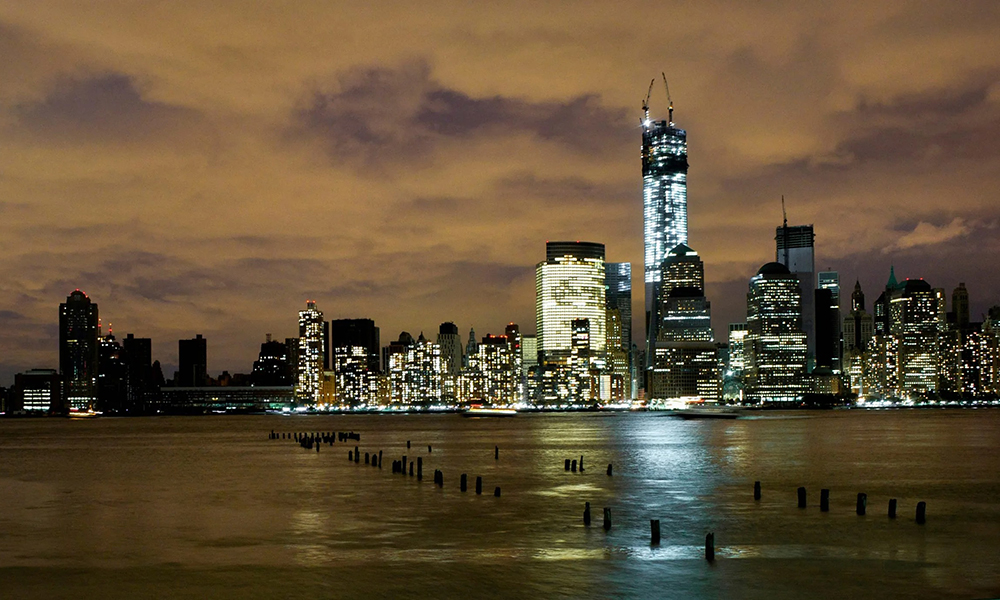纽约市因摩天大楼的重压正在下沉,而这些摩天大楼却开始变得毫无用处
 飓风桑迪过后,纽约市灯火阑珊。图片来源:CULTURA RF/KAREN FOX—GETTY IMAGES
飓风桑迪过后,纽约市灯火阑珊。图片来源:CULTURA RF/KAREN FOX—GETTY IMAGES消息流传开来:纽约市正在下沉(以后将逐渐下沉)。众所周知,全球的海平面已经上升,飓风桑迪过境后,哥谭市(纽约市的别称)遭遇了佛罗里达州级别的大洪水。美国国家海洋和大气管理局(National Oceanic and Atmospheric Administration)最近预测,到2050年,中度洪水的发生频率预计将是现在的10倍以上。这预示着褐色泥水冲进地铁这样的视频数量会是现在的10倍。但研究发现一个令人震惊的事实:著名的纽约天际线正以每次1毫米的速度坠入大海。
研究人员汤姆·帕森斯(Tom Parsons)、吴佩珍(Pei-Chin Wu,音译)、孟威(Meng Wei,音译)和史蒂文·德洪特(Steven D'Hondt)着手“计算纽约市所有建筑物的质量”,同时根据“它们对地球施加的压力造成的沉降”进行建模,并展示从卫星数据中抓取的城市实际沉降的详图。他们发表在《地球的未来》(Earth’s Future journal)杂志上的研究结果显示,纽约市每年已经下沉1毫米至2毫米,有些区域的下沉幅度更大。研究人员补充说,到2050年,海平面可能会上升200毫米到600毫米,对沿海城市和下沉城市(已经在下沉的城市)构成更大的威胁,其下沉速度是稳定地区的4倍。他们预计,随着城市密度增加,世界上大多数城市都会下沉。
摩天大楼的建筑重量削弱了“大苹果城”(纽约市的别称)土壤的稳固能力。研究人员发现,这些建筑的平均质量约为155万磅(703吨),因此所研究的建筑的总质量为1.68万亿磅(7.6亿吨)。而在远程工作时代,鉴于这些建筑越来越空旷,这有点讽刺。换句话说,纽约市可能会因这些毫无用处的建筑物而白白下沉。
就像一只邪恶的橡皮鸭
自新冠疫情爆发以来,越来越多的公司开始要求员工重返办公室办公。但他们基本上没取得实质性进展,因为有些员工对重返办公室的规定(与他们以前的灵活工作模式不同)视而不见。
最引人注目的是,华尔街的领军人物、摩根大通首席执行官杰米•戴蒙(Jamie Dimon)要求员工重返办公室办公,结果却遭到了员工们的抱怨。高盛集团(Goldman Sachs)首席执行官大卫•所罗门(David Solomon)去年表现得非常强势,他命令所有员工都全职回办公室上班。一年后,《财富》杂志的杰夫•科尔文(Geoff Colvin)报道称,许多人都未重返办公室办公,出勤率在65%至69%之间,周五的出勤率几乎为零。根据全国安全公司Kastle Systems的数据,即使今年2月办公室出勤率达到疫情后的高点,也只保持在50.4%,这已成为远程工作职位空缺的主要来源。面对这场艰苦卓绝的战斗,一些首席执行官改变了路线,允许员工采用混合型工作模式。这些现实情况对摩天大楼构成挑战,曾几何时,员工集聚在此,完全受管理者的支配,如今这些摩天大楼却成了让曼哈顿坠入大海的无用之物。
虽然一些(巴塔哥尼亚的)野生动物仍然留在市中心和曼哈顿下城,但该地区仍难以恢复过去的样子。据彭博社报道,纽约市的办公室空置率今年达到了22.7%的历史最低水平。纽约市演变成高楼林立的废城,这一趋势似乎不会很快停止,房地产公司戴德梁行(Cushman & Wakefield)最近预测,由于远程办公,到2030年,美国将有近3.3亿平方英尺的办公空间空置。
即使摩天大楼空置,它们仍是曼哈顿的基石。就像一只邪恶的橡皮鸭,这些摩天大楼可能会在最终的洪水中幸存下来,但作为压力源,它们会加剧未来问题的严重性。但目前人们还无需杞人忧天(气候变化造成焦虑)。上述研究的负责人、地球物理学家汤姆·帕森斯告诉《卫报》:“人们不必立马就陷入恐慌状态,但这一持续过程会增加洪水淹没城市的风险”。话虽如此,研究人员指出,危险的鸡尾酒正在酝酿中,因为“建筑和人为沉降、海平面上升和飓风强度不断增加结合在一起,意味着沿海和河滨地区的问题正在加速恶化。”
即使由于通货膨胀,一些城市居民搬到了更经济实惠的地区,但总体而言,越来越多的人居住在城市地区。研究人员指出,联合国的一项研究表明,到2050年,全球70%的人口将居住在城市。这意味着更多的人将受到环境变化的影响,同时也可能导致环境恶化。研究人员总结说:“据观察,除南极洲外,各大洲的主要城市都在下沉。而且随着人口增长,问题可能会恶化。”在摩天大楼不再像以前的办公大楼那样为我们服务的时代,也许是时候将它们夷为平地了,因为它们肯定对解决气候变化问题无益。(财富中文网)
译者:中慧言-王芳
消息流传开来:纽约市正在下沉(以后将逐渐下沉)。众所周知,全球的海平面已经上升,飓风桑迪过境后,哥谭市(纽约市的别称)遭遇了佛罗里达州级别的大洪水。美国国家海洋和大气管理局(National Oceanic and Atmospheric Administration)最近预测,到2050年,中度洪水的发生频率预计将是现在的10倍以上。这预示着褐色泥水冲进地铁这样的视频数量会是现在的10倍。但研究发现一个令人震惊的事实:著名的纽约天际线正以每次1毫米的速度坠入大海。
研究人员汤姆·帕森斯(Tom Parsons)、吴佩珍(Pei-Chin Wu,音译)、孟威(Meng Wei,音译)和史蒂文·德洪特(Steven D'Hondt)着手“计算纽约市所有建筑物的质量”,同时根据“它们对地球施加的压力造成的沉降”进行建模,并展示从卫星数据中抓取的城市实际沉降的详图。他们发表在《地球的未来》(Earth’s Future journal)杂志上的研究结果显示,纽约市每年已经下沉1毫米至2毫米,有些区域的下沉幅度更大。研究人员补充说,到2050年,海平面可能会上升200毫米到600毫米,对沿海城市和下沉城市(已经在下沉的城市)构成更大的威胁,其下沉速度是稳定地区的4倍。他们预计,随着城市密度增加,世界上大多数城市都会下沉。
摩天大楼的建筑重量削弱了“大苹果城”(纽约市的别称)土壤的稳固能力。研究人员发现,这些建筑的平均质量约为155万磅(703吨),因此所研究的建筑的总质量为1.68万亿磅(7.6亿吨)。而在远程工作时代,鉴于这些建筑越来越空旷,这有点讽刺。换句话说,纽约市可能会因这些毫无用处的建筑物而白白下沉。
就像一只邪恶的橡皮鸭
自新冠疫情爆发以来,越来越多的公司开始要求员工重返办公室办公。但他们基本上没取得实质性进展,因为有些员工对重返办公室的规定(与他们以前的灵活工作模式不同)视而不见。
最引人注目的是,华尔街的领军人物、摩根大通首席执行官杰米•戴蒙(Jamie Dimon)要求员工重返办公室办公,结果却遭到了员工们的抱怨。高盛集团(Goldman Sachs)首席执行官大卫•所罗门(David Solomon)去年表现得非常强势,他命令所有员工都全职回办公室上班。一年后,《财富》杂志的杰夫•科尔文(Geoff Colvin)报道称,许多人都未重返办公室办公,出勤率在65%至69%之间,周五的出勤率几乎为零。根据全国安全公司Kastle Systems的数据,即使今年2月办公室出勤率达到疫情后的高点,也只保持在50.4%,这已成为远程工作职位空缺的主要来源。面对这场艰苦卓绝的战斗,一些首席执行官改变了路线,允许员工采用混合型工作模式。这些现实情况对摩天大楼构成挑战,曾几何时,员工集聚在此,完全受管理者的支配,如今这些摩天大楼却成了让曼哈顿坠入大海的无用之物。
虽然一些(巴塔哥尼亚的)野生动物仍然留在市中心和曼哈顿下城,但该地区仍难以恢复过去的样子。据彭博社报道,纽约市的办公室空置率今年达到了22.7%的历史最低水平。纽约市演变成高楼林立的废城,这一趋势似乎不会很快停止,房地产公司戴德梁行(Cushman & Wakefield)最近预测,由于远程办公,到2030年,美国将有近3.3亿平方英尺的办公空间空置。
即使摩天大楼空置,它们仍是曼哈顿的基石。就像一只邪恶的橡皮鸭,这些摩天大楼可能会在最终的洪水中幸存下来,但作为压力源,它们会加剧未来问题的严重性。但目前人们还无需杞人忧天(气候变化造成焦虑)。上述研究的负责人、地球物理学家汤姆·帕森斯告诉《卫报》:“人们不必立马就陷入恐慌状态,但这一持续过程会增加洪水淹没城市的风险”。话虽如此,研究人员指出,危险的鸡尾酒正在酝酿中,因为“建筑和人为沉降、海平面上升和飓风强度不断增加结合在一起,意味着沿海和河滨地区的问题正在加速恶化。”
即使由于通货膨胀,一些城市居民搬到了更经济实惠的地区,但总体而言,越来越多的人居住在城市地区。研究人员指出,联合国的一项研究表明,到2050年,全球70%的人口将居住在城市。这意味着更多的人将受到环境变化的影响,同时也可能导致环境恶化。研究人员总结说:“据观察,除南极洲外,各大洲的主要城市都在下沉。而且随着人口增长,问题可能会恶化。”在摩天大楼不再像以前的办公大楼那样为我们服务的时代,也许是时候将它们夷为平地了,因为它们肯定对解决气候变化问题无益。(财富中文网)
译者:中慧言-王芳
Start spreading the news, New York’s (gradually) sinking today. It’s well established that sea levels are already rising across the globe, and New York City’s brush with Hurricane Sandy brought a Florida-level flood to Gotham. The National Oceanic and Atmospheric Administration recently projected that in 2050 moderate flooding is projected to occur more than 10 times as frequently as it does now. Cue 10 times as many videos of brown water rushing into the subways. But stunning research finds that the famous New York skyline is falling into the sea, one millimeter at a time.
Researchers Tom Parsons, Pei-Chin Wu, Meng “Matt” Wei and Steven D’Hondt set out to “calculate the mass of all buildings in New York City” while modeling the “subsidence caused by the pressure they exert on the Earth” and to show detailed images of the city literally sinking, scraped from satellite data. Their findings, published by the Earth’s Future journal, showed the city is already sinking 1mm to 2mm a year, and in some places more than that. The researchers add that the sea levels will likely rise by 200mm to 600mm by 2050, posing a greater threat to coastal cities and subsiding cities (cities that are already sinking), at a rate of four times higher than stable regions. Most cities around the world will sink as urban areas become denser, they projected.
The tectonic weight of the skyscrapers weakens the soil of the bobbing Big Apple, as researchers find that the average building mass is around 1.55 million pounds, making the collective mass of the buildings studied 1.68 trillion pounds. And in the age of remote work, it’s a bit ironic, given that these structures are increasingly empty. In other words, New York could be sinking for nothing.
Like an evil rubber ducky
Since the pandemic began three years ago, more companies have been ushering employees back to their offices. But they largely haven’t had great success with this, as some turn a blind eye to mandates that don’t adhere to their previous flexible ways of working.
Most prominently, JPMorgan CEO Jamie Dimon, a dominant figure on Wall Street, called workers back, only to be met with a surge of complaints from employees. Goldman Sachs CEO David Solomon emerged as strongly team office last year, ordering everyone to come in full-time. A year later, Fortune’s Geoff Colvin reported that many just haven’t shown up, and that attendance hovers at 65% to 69%, and almost zero on Fridays. Even when office attendance hit a post-pandemic high in February of this year, it remained only at 50.4%, according to data from nationwide security company Kastle Systems, which has emerged as the leading source on remote work vacancies. Facing an uphill battle, some CEOs have reversed course and allowed for hybrid work. It all puts into challenge the purposes of skyscrapers that were used to hoard employees under managers’ thumbs and are now boondoggles quite literally pressing Manhattan down into the sea.
While some (Patagonia-vested) wildlife remains downtown and in Lower Manhattan, the area still isn’t what it used to be, as Bloomberg reports that office vacancies in NYC reached a record low of 22.7% this year. The skylined ghost town doesn’t seem to be stopping anytime soon, as real estate firm Cushman & Wakefield recently projected that almost 330 million square feet of US office spaces could become vacant by 2030 as a result of remote work.
Even if our skyscrapers stand unused, they’re still letting themselves be known to the bedrock of Manhattan. Like an evil rubber ducky, these skyscrapers might survive eventual flooding, but they’re a stressor that heightens the severity of issues in the future. But there’s no need for paralyzing climate anxiety just yet, “It’s not something to panic about immediately but there’s this ongoing process that increases the risk of inundation from flooding,” Tom Parsons, a leader of said research and geophysicist told The Guardian. That being said, researchers note that there’s a dangerous cocktail brewing, as the mix “of tectonic and anthropogenic subsidence, sea level rise, and increasing hurricane intensity imply an accelerating problem along coastal and riverfront areas.”
Even with some city-dwellers moving out to cheaper areas because of inflation, people are in general increasingly living in urban areas. Researchers point to a study from the United Nations to show that 70% of the worlds’ population will live in cities by 2050. This all means that more will be subjected to this environmental change and also likely lead to worsening it. “Major cities on every continent except Antarctica are observed to be subsiding and the issue may be worsened as populations grow,” conclude researchers. In a time where our skyscrapers don’t serve us as much as the office buildings they used to stand in as, it might be time to do away with them altogether, as they’re certainly not helping the issue of climate change.













